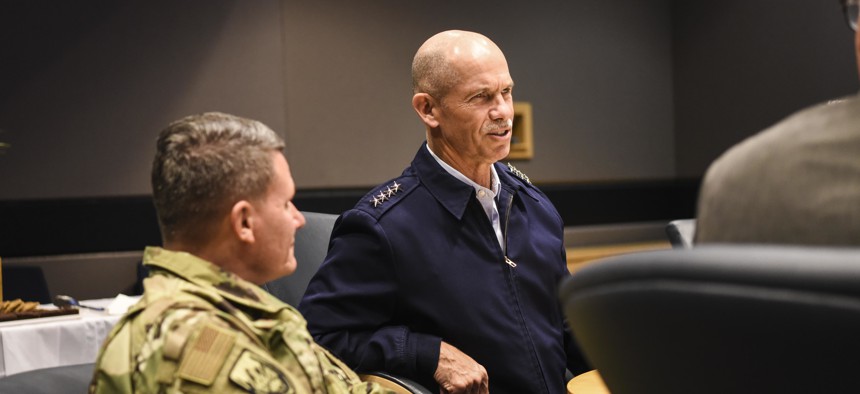
U.S. Coast Guard Vice Commandant Charles Ray speaks with members of Lockheed Martin and Defense Contract Management Agency Col. Lance French at a briefing at the Lockheed Martin facility in Marietta, Ga., Oct. 23, 2018. DOD
Joint Chiefs In Isolation After Coast Guard Vice Commandant Tests Positive For COVID
But multiple officials suggested that they could return to the Pentagon this week.
The Coast Guard’s second-in-command tested positive for COVID-19 on Tuesday, leading all but one of the service chiefs — including Joint Chiefs of Staff Chairman Gen. Mark Milley — to isolate themselves at home, defense officials said.
The flag officers recently attended meetings with the service’s vice commandant, Adm. Charles Ray, who attended a Gold Star family event at the White House the day after the now-notorious ceremony for Supreme Court nominee Amy Coney Barrett.
Vice Chairman of the Joint Chiefs Gen. John Hyten, National Security Agency Director Gen. Paul Nakasone, and Marine Corps Assistant Commandant Gen. Gary Thomas were also in meetings with Ray at the Pentagon since the event. None of Ray’s Pentagon contacts have shown any symptoms of the virus or have tested positive as of Tuesday afternoon, according to a defense official.
It was not immediately clear how long the chiefs were expected to remain in quarantine. Multiple officials suggested that they could return to the building this week if they continue to test negative and no symptoms emerge — even though the White House Gold Star family event widely believed to have been the infection point took place just nine days ago, on Sept. 27.
But the sudden quarantine of almost all of the nation’s top military officers underscored the extent to which the White House itself became a superspreader location, and elevated worst-case scenario fears of a national security apparatus hollowed of senior leaders by a virus that observes no distinction between ranks.
It raised immediate questions about who else at the Pentagon these senior leaders met with, and potentially exposed, during the week between the White House event and Ray’s diagnosis. Some officials point to a Friday meeting in “The Tank,” the Pentagon’s secure meeting room for the Joint Chiefs, as an obvious potential transmission point.
Marine Commandant Gen. David Berger — who attended the White House event but is believed to be the only member of the Joint Chiefs not now self-quarantining — was in the U.K. late last week visiting a British aircraft carrier. Meanwhile, the Air Force’s top generals are holding their quarterly conference this week, although meetings have been taking place in smaller groups than usual, and some leaders are attending via secure video links, according to sources familiar with the matter. A defense official said that Gen. Charles Brown, the Air Force chief of staff, tested negative on Monday before attending one of the meetings.
There are also concerns about Chief of Naval Operations Adm. Mike Gilday, who underwent heart surgery in September for a preexisting condition.
Pentagon spokesman Jonathan Hoffman said in a statement that the abrupt quarantine of so many senior military officials caused “no change to the operational readiness or mission capability of the U.S. Armed Forces.”
“Senior military leaders are able to remain fully mission capable and perform their duties from an alternative work location,” Hoffman said.
But the episode also highlighted the degree to which the Pentagon has sought to carry on business as usual amid the pandemic, with senior leaders maintaining active travel and in-person meeting schedules in recent months. On Monday, Lisa Gordon-Hagerty, head of the National Nuclear Security Administration, attended meetings at U.S. Strategic Command headquarters in Omaha, Nebraska. Most photos posted from the trip show officials wearing masks as they sit around conference tables. Air Force Secretary Barbara Barrett, Air Force Chief Brown, and Gen. Jay Raymond, the chief of space operations, were in Colorado in late September, for a change-of-command ceremony at the Air Force Academy.
“DoD has been following CDC guidelines since April with respect to temperature testing, social distancing, and the wearing of masks to the greatest extent when social distancing is not possible and will continue to do so,” Hoffman said.
President Trump announced that he had been diagnosed with the virus early Friday morning, and was released from Walter Reed Medical Center on Monday evening. But concerns have continued to swirl about the health of the commander-in-chief after videos emerged that appeared to show him struggling to breathe, and outside analysts have raised concerns that foreign adversaries will perceive the United States as distracted and therefore vulnerable to potential attack — in particular to propaganda and other information warfare tactics.
Bloomberg reports that Trump wants to return to the Oval Office as early as Tuesday.
Marcus Weisgerber contributed to this report.




